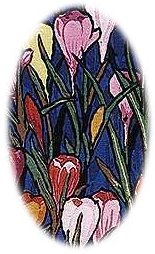 The Episcopal Dean Howard
Chandler Robbins wrote an "Easter Carol for
Children" in 1929 (The Sabbath Day Was By)
that has become a popular hymn among Protestant
congregations in the United States. Another recent carol
is the poem "O Who Shall Roll Away the Stone?"
written by Reverend Marion F. Ham, a Unitarian minister.
The text was first published in the Boston Transcript,
in April 1936, and the tune composed by the American
organist and choirmaster T. Tertius Noble in 1941.
Of liturgical texts set to music, the best known are
the Gradual for Easter, Haec Dies quam fecit Dominus
(This Is the Day Which the Lord Has Made). This
text both in the original Latin or in translations has
been set to music by several composers and sung in
churches of all Christian denominations. This is also
true of the Offertory in the Easter Sunday Mass, Terra
tremuit (The Earth Trembled).
In Catholic churches the Regina Coeli Laetare
(Queen of Heaven, Rejoice) is prescribed as
antiphon of the Blessed Virgin for Easter time. The text
is a fourteenth-century Latin poem, and is sung both in
Gregorian chant and various musical settings all through
the Easter season. Another hymn often used in Catholic
churches is Regina Coeli Jubila (Queen of
Heaven, Rejoice). This Latin poem appeared first in
1600; the author is unknown.
Among the great oratorios that glorify the
Resurrection of Christ, the earliest is Antonio
Scandello's Auferstehungsgeschichte (Story
of the Resurrection), composed about 1560. It was
first performed in the Royal Court Chapel at Dresden.
The latter part of Handel's Messiah deals
with the Easter story. Every year at its performance
thousands are inspired by "I Know that My Redeemer
Liveth," and by the "Hallelujah Chorus,"
during which all audiences traditionally rise from their
seats.
Charles Gounod's Redemption is another source
of familiar Easter music. This work, once very popular,
is now rarely performed, though in many churches Easter
Day would not be complete without the resounding chorus
"Unfold Ye Portals." Similar passages of Easter
music are found in the famous choral works of Cesar
Franck (Redemption) and A. R. Gaul (The Holy
City).
Of purely instrumental works inspired by the
Resurrection, the elaborate overture "Bright
Holiday" or "Russian Easter" by Nicholas
A. Rimsky Korsakoff (1908) is most widely known. Based on
themes from "Obichod," a collection of
canticles of the Orthodox Church, it presents a vivid
picture of the Russian Easter Day celebration.
The "Resurrection Symphony" of Gustav Mahler
(1911), while not inspired by the Gospel narrative
itself, nevertheless owes it existence to Mahler's
contemplation of death and resurrection as a prelude to a
new and purified life.
Of the innumerable shorter works, whether choral or
instrumental, special mention should be made of Johann
Sebastian Bach's several cantatas on Easter texts. There
are, of course, also countless short organ pieces
inspired by the Resurrection.
Finally, here are a few of the countless popular
Easter songs as they exist among all nations.
A Spanish Easter hymn of great power is the song Jesucristo,
Rey Glorioso, from Ecuador:
As the Saints in Heaven praise Him
The Chinese Christians have many beautiful native
hymns. An example is the music of an alleluia series,
which is attached to the Chinese text of Psalm 112
("Praise, O servants of the Lord, praise the name of
the Lord").[56] Alleluia, alleluia, Alleluia, alleluia,
An Easter hymn in honor of the glorified body of the
Risen Lord is this ancient Tyrolese song (Ist das der
Leib, Herr Jesu Christ):
Is this thy body, risen Christ, From now through all eternity Thy glory, Christ, I cannot bear,
| |
|
A free translation of the ancient Latin hymn Surrexit
Christus Hodie (Christ Is Risen Today) is
the Hungarian Easter song Feltamat Krisztus:
Christ rose today, alleluia. Death did He crush, alleluia, Love made Him die, alleluia,
The Lithuanians sing at Easter the traditional hymn Linksma
diena mums prasvito (The Joyful Day Has Dawned
for Us):
Joyful the day that dawned for us, He broke the reign of death and sin, An angel now in love he sends,
A jubilant note of Easter joy pervades the music of
the traditional Portuguese hymn A Terra treme (The
Earth Trembled):[57]
An earthquake shook the rocky tomb,
Johann Wolfgang Goethe (1832) indicates in the
Osterlied of his famous poem Faust, with classic
brevity and clarity of expression, the basic motif of all
popular Easter songs:
Christ is arisen: | |
|
|
|
| Previous | Return to Easter Page |
 Jesus Christ, the King of
glory,
Jesus Christ, the King of
glory, 